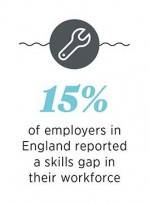Universities are in turmoil. The internet has undermined the old ways of educating students. Professors used to stand in an auditorium and deliver a lecture. But what is the point when students can download the entire series to peruse at their leisure?
So what should universities do? A simple way to discover how learning can be reinvented for the 21st century is to take a look at what’s happening in the business sector.
Commvault, a data management company, created Commvault University to train employees. It embraces teaching methods millennials – 20 and 30-somethings – will enjoy most. In essence Commvault University is an intranet-based portal that allows all employees to browse a library of resources.
Staff are taught in small groups of eight to thirteen people to ensure we provide an intimate setting whereby we can cater for all abilities
“There is a lot of evidence that shows that millennials, having grown up with Google and YouTube, are far more used to resourcing their own personal development and doing so through multiple channels,” says Commvault HR director Susie Andrew.
“What we’re doing at Commvault is we’re replicating that. The Commvault University allows students to work at their own pace, in a way that is interesting to them and not just limited to their specific role. Every learning module they complete is logged on their profile, so at the same time as learning, they are creating an internal CV which shows their commitment and achievements.”
It’s not all static; there are interactive webinars and guest speakers, such as management gurus Clayton Christensen and Marcus Buckingham, hold workshops.

Training at Pets Corner
Pets Corner runs a tuition programme to put Russell Group universities to shame. Ten training staff run courses for employees located in 100 pet stores around the UK. Head of training Lucy Ross says: “Staff are taught in small groups of eight to thirteen people to ensure we provide an intimate setting whereby we can cater for all abilities and experiences within the pet industry. Currently we have 378 different manuals for staff, 25 of which are nutrition-specific for learning on the shop floor. The manuals are continuously updated so that our staff can keep their knowledge current and relevant.
 “Our current sessions cover 12 different topics. These are mammal husbandry, reptile husbandry, aquatics care and maintenance, aquatic product knowledge, wild bird and home farming, treatments and grooming, pets and parasites, dog training and products, cat behaviour and care, the pets corner difference and customer service, systems and policies, and management training – so it’s a very intensive and broad schedule.
“Our current sessions cover 12 different topics. These are mammal husbandry, reptile husbandry, aquatics care and maintenance, aquatic product knowledge, wild bird and home farming, treatments and grooming, pets and parasites, dog training and products, cat behaviour and care, the pets corner difference and customer service, systems and policies, and management training – so it’s a very intensive and broad schedule.
“On completion of each session staff are required to pass a test to ensure they understand the subject and possess the core knowledge necessary for delivering the Pets Corner standard. To keep up to date with changes, each member of staff will then need to repeat these sessions within 18 months.”
There’s no tolerance for a failure to learn. All staff must pass a written exam before they are allowed to sell to the public. Ms Ross tried the softly-softly approach. It didn’t work. “We have made our in-house curriculum mandatory. Before this we have tried setting certain sessions within the working rotas and allowing staff to volunteer themselves to expand their knowledge. This, as you can imagine, was a disaster. We would have some staff members putting themselves forward with a real drive and thirst for learning and knowledge, which was fantastic. But those who were less confident in their knowledge felt overwhelmed or even perhaps lazy and would not volunteer themselves,” she says.
Putting in practice
Since implementing our new training programme and incentive scheme, we’ve seen employee satisfaction go through the roof
A persistent criticism of university teaching is that it is too desk-bound. Businesses can’t afford to have staff competent only in the theory. Stone Junction, a technical PR agency, is typical of the way the best companies approach training. Richard Stone, managing director, says: “We apply the 70/20/10 model in our training: 70 per cent consists of getting employees to actually practise what they learnt, 20 per cent consists of being told how to do new things and 10 per cent is desk research.”
Mr Stone makes sure his protégés get out of the office. “Our training programme is also complemented with external training days, webinars and tech talks, industry events and trade shows, as well as trade body membership and continuing professional development,” he says.
Staff get a lot of autonomy through an annual grant to spend on non-vocational training. They also train each other. “We encourage everyone to share any skills or knowledge they have with the rest of the team. This way the trainee becomes the trainer,” says Mr Stone.
The net result is a workforce constantly engaged and learning. Mr Stone adds: “Since implementing our new training programme and incentive scheme, we’ve seen employee satisfaction go through the roof. It’s also helped our staff retention, which is crucial for any small company.
“Believe it or not, we’ve already discovered hidden talents within the team. One of our graduates turned out to be a video and audio-editing expert – an extremely handy set of skills for any company, but especially relevant when you’re working in the media sector.”
Taking the time to lea
A key question is how much training to give. Too little, and the impact is diminished. Too much, and staff are distracted from their job. McDonald’s is known for its exemplary record on training. It always ranks as one of the best places to work in the UK and is overall rated “good” by Ofsted, and “outstanding” for apprenticeships. More than 18,000 employees have gained a qualification through the scheme over the last five years. The programme includes qualifications in maths and English, and foundation degrees. Half of current managers started as apprentices. The full training and development budget runs to £40 million a year, an average of 75 hours per employee.
At law firm Osborne Clarke, the average training time is similar at 70 hours a year. That might seem a lot, but it amounts to an hour and half a week. At HCSS Education, an education finance specialist, employees fit in tuition at “lunch and learns”. The slot can cover a variety of skills from time management to lessons learnt from a company project. It proves that lack of time need be no excuse.
Companies innovate in education because their futures depend on it. Universities, operating in an environment where students queue to sign up and then almost never transfer to another provider, have mostly been slower to adapt. They and their students would do well to observe – and learn.
CASE STUDY: WOLFF OLINS
Wolff Olins is the legendary branding agency behind famous logos such as Orange mobile and the London 2012 Olympic Games. It runs a phenomenally broad and deep education programme.
 Ellen O’Connor, head of learning and development, explains her approach: “We have a peer-to-peer learning programme – a curriculum of training courses across our four offices in London, New York, Dubai and San Francisco, designed and led by experts internally. At the moment 3D Printing 101 is really capturing people’s imaginations and our Presenting course is always a favourite.
Ellen O’Connor, head of learning and development, explains her approach: “We have a peer-to-peer learning programme – a curriculum of training courses across our four offices in London, New York, Dubai and San Francisco, designed and led by experts internally. At the moment 3D Printing 101 is really capturing people’s imaginations and our Presenting course is always a favourite.
“We call this selection of on and offline courses Curve. The key to its popularity and impact is keeping it refreshed with new content which is aligned to our business needs. Our people love learning from each other, and our faculty love developing their skills in presenting, facilitating and sharing their knowledge. It’s a double learning loop.
“We’re currently launching our own Leadership Development Programme too, an evolution of everything we’re already doing.
“We also have more social learning groups such as our Cookery Club, run by our head chef Sam, which cements a positive attitude to learning, creativity and teamwork. Externally, we invite people to attend Omnicom University, which is run by the parent company of our group, offer courses at places such as General Assembly, a great school for new skills in programming, design and marketing, as well as interesting schools such as the Institute of Interaction and Design in Copenhagen.
“Everyone at Wolff Olins can apply for a personal learning grant as part of their development plan; individuals make a case for the training they want to do, and how it will support their plan and contribute to their current and future work. The amount we contribute is flexible dependent on the course and our perceived value of those skills within the business. We have an agreement with those attending longer courses that they will share their learnings afterwards, so we all get the benefit.
“We find that the variety of learning options helps to create high engagement, and by empowering our people to teach, we’ve established a shared sense of responsibility for learning and teaching, and beyond that helping others and the business grow.”

Training at Pets Corner

